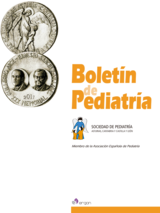Importancia del reflujo vesicoureteral en Pediatría. Seguimiento conjunto del paciente entre Nefrología y Cirugía Pediátrica
R. Garrote Molpeceres , A. Sánchez- Abuín , V. Arroyo Alonso , O.D. Gómez Beltrán , M.E. Molina Vázquez , R. Aguilar Cuesta
Bol. Pediatr. 2019; 59 (248): 98 - 107
El reflujo vesicoureteral (RVU) es la malformación nefrourológica más frecuente del recién nacido, pudiendo aparecer de forma secundaria en otras patologías malformativas, como en el caso de las valvas de uretra posterior, o ser secundario a una disfunción de la unión ureterovesical. De esta manera se distinguen dos fenotipos de pacientes, por un lado los diagnosticados en época prenatal o neonatal, generalmente varones, con afección anatómica y/o funcional de la unión ureterovesical, lo que se conoce con el nombre de “RVU primario”, frente a formas postnatales en el escolar mayor, generalmente mujeres con disfunción vesical y de la unión ureterovesical, conocidas como “RVU secundario”. Estas formas clínicas presentan distinta evolución clínica y pronóstico, con desarrollo de enfermedad renal crónica (ERC) debida a un mal desarrollo nefrourológico asociado o no a infecciones urinarias recurrentes. La técnica gold standard para diagnosticar daño renal es la gammagrafía renal DMSA Tc99 mientras que la prueba diagnóstica de RVU es la cistouretrografía miccional seriada (CUMS). El tratamiento inicial debe ser conservador optimizando medidas higiénicas, dada la posibilidad de resolución espontánea del mismo con el tiempo, principalmente de las formas leves de RVU, reservando el tratamiento quirúrgico correctivo en las formas severas y con mala evolución clínica, por el probable desarrollo de ERC que puede conducir al paciente a una enfermedad renal terminal con necesidad de técnicas de depuración extrarrenal o incluso trasplante renal. Dicho tratamiento quirúrgico será preferentemente endoscópico.Aún existe controversia en el uso de profilaxis antibiótica, recomendándose en casos concretos. Un manejo integral multidisciplinar del paciente mejorará su pronóstico renal y vital, así como su calidad de vida y la de su familia.
Importance of vesicoureteral reflux in Pediatrics. Joint patient follow-up between Pediatric Nephrology and Pediatric Surgery
Vesicoureteral reflux (VUR) is the most frequent nephrourological malformation of the newborn, and may appear secondary in other malformative pathologies, such as in the case of the posterior urethral leaflets, or be secondary to a dysfunction of the ureterovesical junction. In this way, two phenotypes of patients are distinguished, on the one hand those diagnosed in the prenatal or neonatal period, generally males, with anatomical and/or functional affection of the ureterovesical junction, which is known as the “primary VUR”, compared to postnatal forms in the older schoolchild, generally women with bladder and ureterovesical junction dysfunction, known as “secondary VUR”. These clinical forms present different clinical and prognostic evolution, with development of chronic kidney disease (CKD) due to poor nephrourological development frequently associated with recurrent urinary infections. The gold standard technique for diagnosing kidney damage is nuclear renal scanning with dimercaptosuccinic acid (DMSA), while the diagnostic test for VUR is voiding cystourethrography (VCUG). Initial treatment should be conservative, optimizing hygienic measures, given the possibility of spontaneous resolution of it over time, mainly in mild forms of VUR, reserving corrective surgical treatment in severe forms and with poor clinical evolution, due to the probable development of CKD that can lead the patient to end-stage kidney disease with the need for extrarenal clearance techniques or even kidney transplantation. Surgical treatment will preferably be endoscopic. There is still controversy in the use of antibiotic prophylaxis, being recommended in specific cases. A comprehensive multidisciplinary management of the patient will improve their renal and vital prognosis, as well as their quality of life and that of their family.
Artículo completo (PDF) (751 kb.)
- Nefrourología
